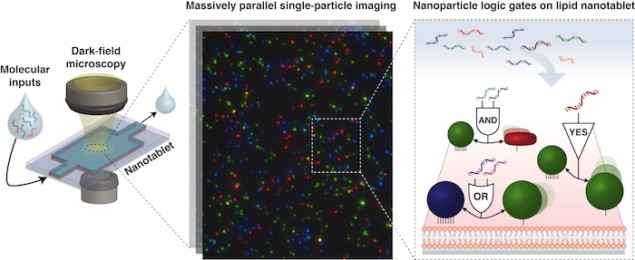
A new “lipid nanotablet” that resembles a biological cellular membrane in the way that it works can perform Boolean logic operations. The device is made of nanoparticles functionalized with surface chemical ligands of DNA that act as computational units tethered to a lipid bilayer circuit board. It could find use in a host of applications, including biocomputation, nanorobotics, DNA nanotechnology, biointerfaces and smart biosensors.
“In nature, cell membranes are analogous to a circuit board as they organize a wide range of biological nanostructures (such as proteins) as units that can be thought of as tiny computers,” explains Jwa-Min Nam of Seoul National University (SNU) who led this research study. The membranes compartmentalize the proteins so that they are separated from extracellular fluids that contain information important for vital functions. Each protein receptor takes chemical and physical cues (which can be processes like ligand-binding or changes in membrane voltage) from its environment as inputs and then generates outputs. These can be structural changes or dimerization/dissociation reactions, for example.
“These nanostructures allow the membranes to dynamically interact with each other and carry out complex functions as a network,” says Nam. “The ‘biocomputing’ processes they perform are massively parallel and are key to how living systems adapt to changes in their environment.”
Synthetic cell membrane circuit board
Nam and colleagues’ lipid bilayer is to all intents and purposes a synthetic cell membrane circuit board on which information-processing nanostructures are tethered using biomolecules. In their work, they use light-scattering plasmonic nanoparticles as the circuit components (instead of proteins) and DNA as surface ligands. To perform computation, they programme the ways the tethered nanoparticles interact with one another using the surface ligands.
When placed in a solution containing DNA strands, the computing units change their structure as they sense these molecules. This is the input signal for the single-nanoparticle logic gate that then triggers particle assembly and disassembly as the output. The researchers employed high-resolution dark-field microscopy, which detects the strong and stable light scattering signals from the nanoparticles to track them and their interactions.
The SNU team says it can also couple multiple nanoparticle computing units into a reaction network and thereby wire a number of logic gates into a combinatorial circuit, such as a multiplexer, for more complex information processing. “Using this approach, which we call ‘interface programming’, we show that a pair of nanoparticles on the lipid bilayer can carry out AND, OR and INHIBIT logical operations, taking multiple inputs (‘fan-in’) and generating multiple outputs (‘fan-out’),” says Nam.
Scalable architectures
One of the goals in this work was to use individual nanoparticles as linking nano-parts. “Our concept proves that we can reliably implement such modular and molecular (in this case DNA) computing with nanoparticles for the first time,” he tells Physics World.
“Such scalable architectures have been lacking until now because of the difficulties in wiring multiple logic gates into large electronics circuits in solution – inputs, logic gates, and outputs all diffuse uncontrollably around, and in all directions.” Indeed, previous such nano-biocomputation was limited to one simple logic operation per test tube due to lack of compartmentalization or relied on complicated enzyme-based molecular circuits in solution. Tethering the nanoparticles means that they are sorted from the solution in which they are in and can only interact with each other in one direction – as they diffuse across the surface of the lipid bilayer. They can thus be controlled, says Nam.
The advantage of the new approach is that it should now be possible to incorporate a variety of nanoparticles, with their intrinsic features – such as their photonic, catalytic, photothermal, optoelectronic, electrical, magnetic and material properties – into the lipid nanotablet.
“In this way, we can design a network of particles (each with their own unique properties) to autonomously respond to external molecular information on such a platform,” explains Nam. “Being able to control these nanoparticle networks in a programmed way will be very useful for developing applications like smart sensors, precise molecular diagnostics and nanorobots for biological environments. We will also be able to make hitherto inaccessible nano-bio-interfaces and biological hybrid systems.”
Full details of the research are reported in Science Advances 10.1126/sciadv.aau2124. The work was funded and supported by Samsung Research and the Incubation Center of Samsung Electronics (SRFC-MA1502-02).



